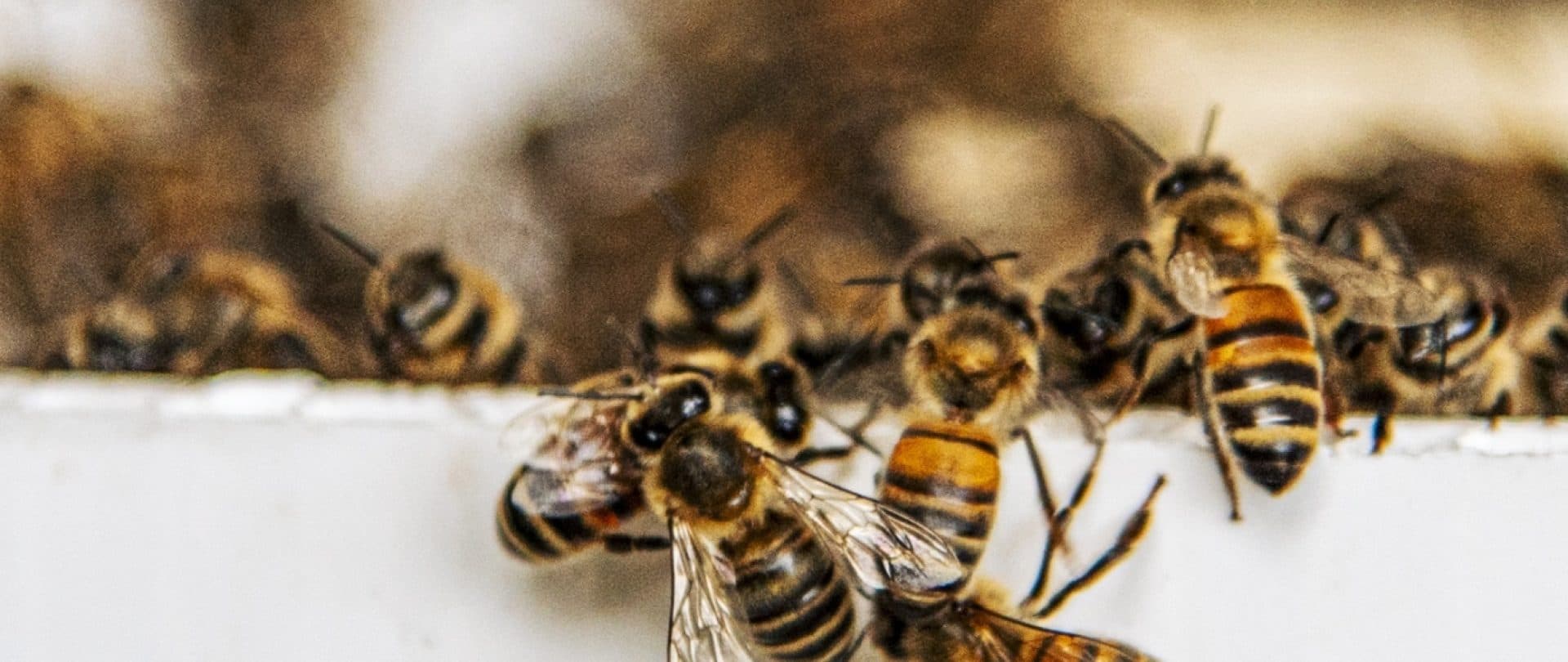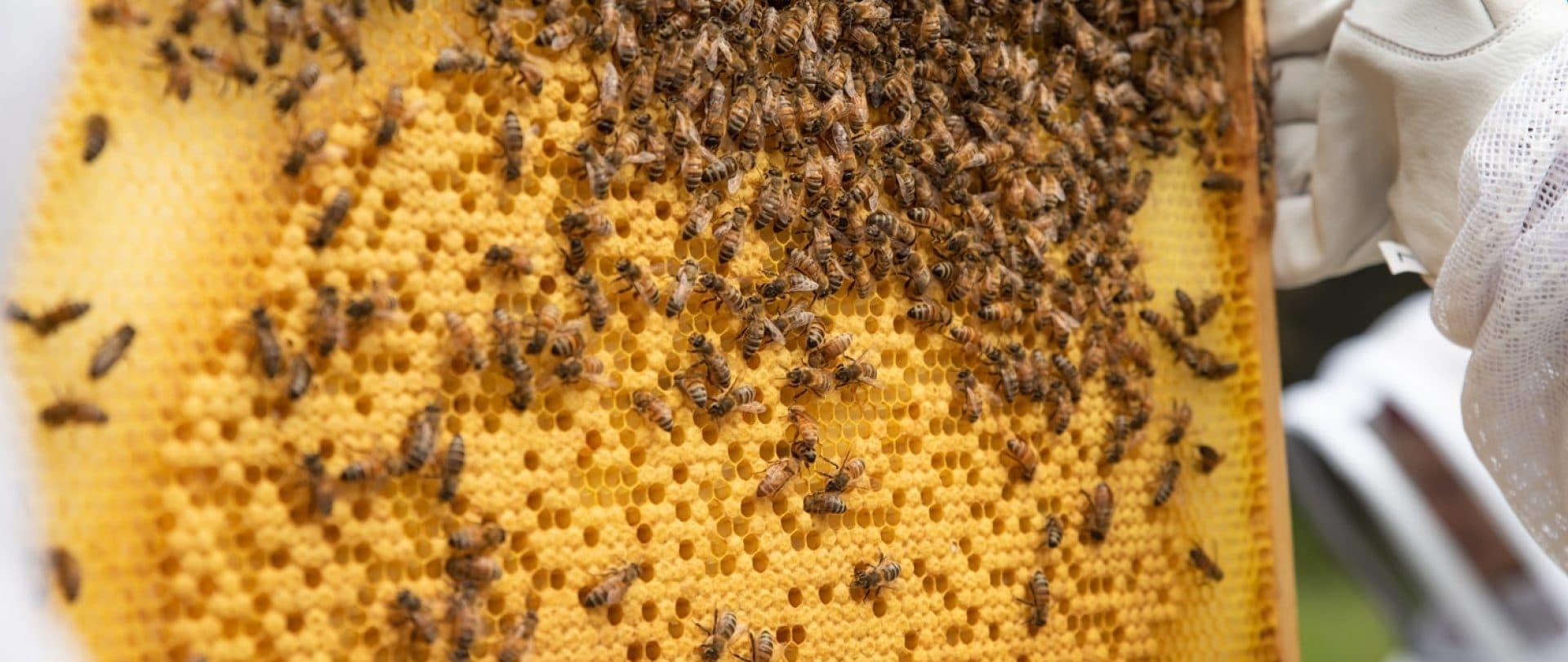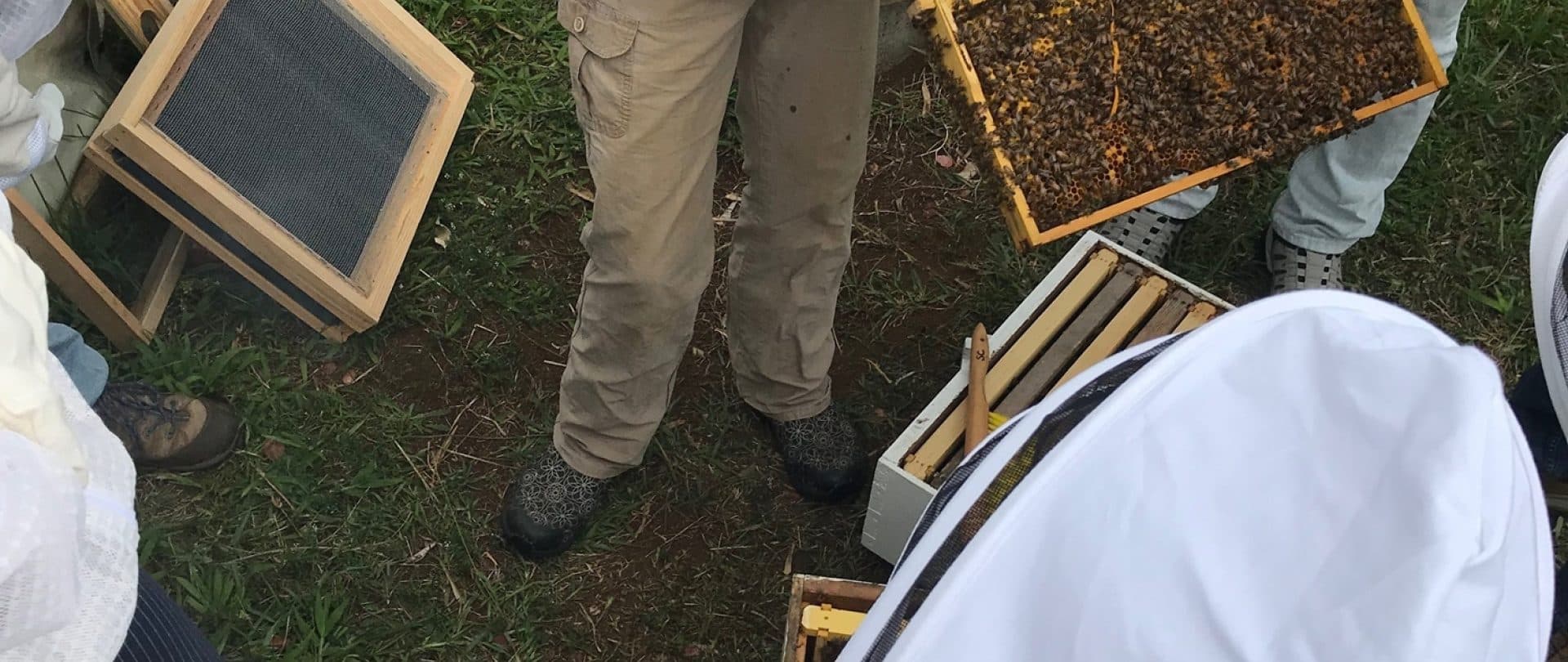Nature's Keepers
The fundamental role honeybees play in our ecosystem and how Hawai'i's beekeeping community is working to save them
BY Krystal Kakimoto
Many people are familiar with the soothing hum of honeybees and the delicious honey they produce. However, honeybees offer much more. They are essential for the survival of our ecosystem, as they pollinate over 130 different crops of fruits and vegetables. It is estimated that the efforts of these hardworking pollinators contribute more than $15 billion to the U.S. economy each year. If honeybees were to become extinct, experts predict that this would lead to an economic crisis and significant changes to our ecological community.
About Honeybees
Native to Europe, Africa and parts of Asia, honeybees are tiny flying insects most known for the hives they create from beeswax. A honeybee hive is a well-organized social structure where bees work together to keep their colony healthy. The roles of honeybees are divided into three types of adult bees. There are the queens who serve as the central figure for the colony. Queens are responsible for laying eggs and emanating pheromones to control the mood of the hive. Worker bees perform activities to keep the hive healthy, such as foraging for pollen and nectar, protecting the hive from predators and feeding the queen, drones and larvae. Finally, there are drone bees whose primary focus is to mate with the queen.
From a beehive, many products can be created. The wax is often harvested and used to make cosmetic products and candles and used in food preparation. The propolis, a sticky, resinous substance that bees collect from plants, has been used for thousands of years as a medicinal product. It is often applied to wounds for its anti-inflammatory and antimicrobial properties or ingested as a supplement to treat a variety of ailments. However, the most popular product created by bees is honey, which is created by collecting nectar from flowers, breaking down the nectar into simple sugars and storing it in honeycomb cells. Worker bees fan their wings to create air currents to evaporate water from this stored nectar, which helps with the process of converting flower nectar to honey.
Honeybees in Hawaiʻi
The history of honeybees in Hawaiʻi dates back to August 1851 when, at the first meeting of the Royal Hawaiian Agricultural Society, a committee was appointed to bring the first honeybees to the islands. The committee was able to have a single hive shipped from Boston to Honolulu in 1852, but the ship transporting the hive passed through the tropics, and the increase in temperature melted the honeycomb killing the honeybees. Around the same time, a second hive was ordered from New Zealand, but due to a miscommunication, the hive was never shipped. The following year, another attempt was made to order hives from Boston. This time, two hives were shipped with one hive packed in ice. The hives arrived in poor condition and were auctioned to Charles Reed Bishop, the husband of Princess Bernice Pauahi Bishop, for $13.00, but the honeybees ultimately died. It was not until 1857 that three hives of German dark bees were shipped to Honolulu from California. After 18 days at sea, the hives arrived and were purchased by the Society for $100 each. The hives were placed under the care of Dr. William Hillebrand, who nursed the colonies at his home in Nuʻuanu, Oʻahu. The hives flourished, growing from three to nine colonies, and were later brought to the other Hawaiian islands.
As the decades passed, the interest in honeybees boomed, but not just for the delicious honey they produced. In the 1890s, entrepreneurs from the United States saw the potential Hawaiʻi held in cattle ranching and subsequently introduced many cattle to the islands. In turn, they required nutritious feed for their cattle and sought the seeds of the Kiawe tree. To pollinate these trees, ranchers turned to honeybees to promote pollination, creating a symbiotic relationship.
Honeybees and the Ecosystem
Honeybees are a crucial pollinator in our ecosystem. It is estimated that one in every three bites of food comes from products that required pollination. In Hawaiʻi, honeybees are responsible for the pollination of crops such as macadamia nuts, coffee, guavas, papayas, avocados and bananas, as well as native plants such as ʻōhiʻa lehua, naupaka and ʻilima, the island flower of Oʻahu. In addition to transferring pollen between flowers, while enabling plant reproduction, honeybees play a crucial role in maintaining the biodiversity of the world’s crops, and without bees, many of the world’s plants would struggle to thrive, which would lead to significant ecological disruptions.
Threats to their Survival
While honeybees benefit from the moderate climate of Hawaiʻi, many threats put their species at risk. There are external threats such as fungus, pests and diseases that can spread through a colony, putting the overall health of the hive at risk. Within the past 20 years, a serious issue called Colony Collapse Disease, or CCD, has been seen throughout the world, translating into thousands of dead colonies and millions of dead bees.
While the root cause of CCD is unknown, scientists believe it is likely a combination of factors, which include malnutrition, poor beekeeping practices, invasive varroa mites and the use of pesticides on crops near hives. While not the central issue of CCD, many beekeepers and scientists note the harmful effects that pesticides have on colonies. Death is often the result of honeybees who come into direct contact with the chemicals while foraging, but even brief contact can have lasting effects on them. Paralysis, wobbly movements, impaired foraging abilities and fewer offspring are some common side effects of pesticide exposure. Many honeybees also display memory loss, akin to dementia in humans, ultimately forgetting how to return to the hive and eventually dying.
Supporters and Advocates for Honeybees
Throughout the islands, advocates for these unsung heroes are coming together to create better conditions for honeybees and pollinators. One such person is Susan Collins of Bird and Bee Hawaiʻi. Her introduction to the world of honeybees came in 2016 when she discovered a small swarm of bees on her property. Over the coming months, Susan was fortunate to connect with mentors who supported and guided her along her journey into beekeeping. Today, she has a five-acre farm in Honokaʻa where she hosts beekeeping classes and tours to educate beekeepers and share her knowledge with the public. Visitors are welcome to take part in her two-hour tours which begin with education on honeybees and how important they are for our environment. Each participant is then given a bee suit and gloves, and the entire class heads to the hives, where the hands-on portion of the tour begins. After handling and interacting with the bees, the group heads back to the classroom where Susan offers fresh, Big Island honey for the group to enjoy. She has also created a four-part course to help everyone, from beekeeping enthusiasts to experienced beekeepers, have thriving hives. Covering topics like hive basics, conducting hive inspection, and the proper equipment to set you up for success, Susan is paying back the support she received when she entered the industry through her classes and tours.
She is also working hard to bring together the beekeeping community with her World Bee Day festivities. World Bee Day began in 2018 when the General Assembly of the United Nations proclaimed May 20 as the day when international communities would raise awareness of the essential roles of bees and pollinators and the challenges they face. Susan is bringing this global celebration to Hawaiʻi with her second annual event, which will be held on May 17, 2025, in Hilo. At World Bee Day Hawaiʻi, she will bring together fellow beekeepers who will host live talks on beekeeping, honey-tasting sessions and live demonstrations. The event is free and open to the public and is an excellent way to learn about the fundamental role honeybees play in our ecosystem and what can be done to help these hidden gems of nature prosper.
Visit birdandbeehawaii.com for more information on Bird & Bee Hawaiʻi. Visit worldbeedayhawaii.com for more details on World Bee Day Hawaiʻi.





